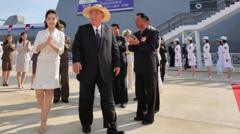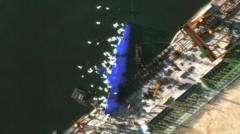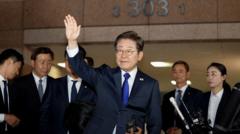Following the capsizing and rapid repair of a warship, Kim Jong Un's reaction has revealed strategic insights into how the North Korean regime manages failure and builds support among its citizens.
Kim Jong Un's Warship Drama: A Lesson in North Korean Resilience

Kim Jong Un's Warship Drama: A Lesson in North Korean Resilience
The capsizing of a North Korean warship serves as a fascinating case study in the regime's manipulation of public perception and reinforcement of loyalty.
The recent capsizing and swift relaunch of a warship in North Korea has captured significant international attention and offers intriguing insights into the regime’s inner workings. The incident, which began with the warship's unsuccessful launch last month, saw Kim Jong Un quickly react by condemning the failure as a "criminal act" that tarnished national dignity. The harsh fallout included immediate arrests of four party officials while Kim demanded a hasty restoration of the vessel.
Analysts suggest that the focus should not solely be on the incident itself, but rather on the regime's response, which indicates North Korea’s ambition to enhance its naval capabilities amidst an overwhelming emphasis on military power. Despite the nation having a nuclear arsenal, its navy is significantly outdated. Thus, the construction of new warships—capable theoretically of deploying nuclear short-range missiles—marks a critical step in Kim's strategy to modernize naval forces, especially against rivals such as South Korea and the United States.
Current assessments argue that the botched launch may have been both an embarrassment and an opportunity for Kim. Experts note that such incidents of ship capsizing are extremely rare, signifying potential shortcomings in North Korea’s naval construction capabilities. Kim's attendance, alongside his daughter's, at the launch ceremony only intensified the stakes of the event, transforming it from a technical failure into an ideological battleground.
Formerly, the Kim regime would typically suppress negative events to maintain its narrative of strength. However, experts like Rachel Minyoung Lee argue that Kim has opted to publicly address the incident—transforming it into a display of accountability and urgency. By highlighting a worker’s dedication who perished during construction, Kim has shifted the narrative towards communal loyalty while avoiding presenting himself as infallible.
The quick restoration of the warship in under a month—defying many naval expectations—has further solidified the regime's messaging. Analysts like Kim Dong-yup note that even failure can be metamorphosed into a political triumph, effectively enhancing public commitment to the regime. By framing setbacks as challenges that are promptly rectified, North Korea aims to present an image of resilience and progress toward its goal of a modern naval power.
This incident underlines a crucial transformation within North Korean political strategy, showing Kim Jong Un's adeptness at manipulating narratives to strengthen regime loyalty. As Kim continues to pursue a military modernization agenda that aspires to include a formidable naval force, experts stress the need for vigilance on the global stage regarding North Korea's growing ambitions. The broader implications of these developments suggest a persistent evolution of the regime into one that seeks to project power beyond its shores, potentially altering regional geopolitical dynamics.





















